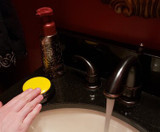Encouraging Unilateral Weight-Bearing Exercises with a Switch-Adapted Toy: Ideas for Physical Therapy and Home Treatment Carryover
When working with young children who have limited understanding of cause and effect, finding ways to engage them in physical therapy can be a challenge. A particularly effective strategy involves using positive reinforcement, such as activating a switch-adapted toy, to motivate the child to perform specific therapeutic activities. Unilateral weight-bearing exercises, which are essential for building strength, coordination, and motor skills, can be made more fun and rewarding through this approach. Let’s dive into how this can work and why it’s so effective.
The Power of a Switch-Adapted Toy
For children with limited understanding of cause and effect, immediate rewards are a key motivator. A switch-adapted toy – a toy that activates with a simple press of a switch – can be a fantastic tool in encouraging children to perform certain actions, like unilateral weight-bearing exercises, correctly. These toys can be activated by a switch, allowing the child to see an instant outcome of their effort.
When the child performs the exercise (e.g., placing weight on one hand or leg), the therapist or caregiver can activate the toy by pressing the switch. This immediate cause-effect connection is critical for the child’s learning process. Over time, the child begins to associate the action (performing the exercise) with the reward (the toy’s activation), encouraging them to repeat the behavior.
While this article focuses on unilateral weight-bearing exercises, it’s important to note that this technique can be applied to a wide range of therapeutic activities. Whether the goal is to encourage crawling, stretching, or any other physical exercise, using a switch-adapted toy to reinforce the desired behavior is a versatile tool that can enhance many exercises and make them more engaging for children.
Choosing the Right Toy
When selecting a switch-adapted toy, it’s crucial to choose one that will truly engage the child. The toy should be something the child enjoys interacting with, as this will increase their motivation to participate in the activity. If the child is excited about the toy, they will be more likely to perform the exercise correctly in order to activate it. Whether it’s a toy that makes fun sounds, lights up, or moves, the key is to make sure it aligns with the child’s interests. This ensures that the reward is both motivating and enjoyable, making the therapy session feel more like play and less like work.
Why Timing is Everything
Timing is key when using this technique. The switch-adapted toy should only be made available to the child during the therapy session, and it should be activated only when the child performs the task correctly. If the toy is readily available outside of the therapeutic setting, the child may lose interest in working for it. They could quickly realize that they can access the toy without putting in any effort, which means the incentive to participate in the exercise becomes less motivating.
To ensure that the toy retains its value as a reward, caregivers and therapists should:
- Limit Access to the Toy: Keep the toy out of sight when not in use during therapy sessions. This keeps the toy special and exciting when it’s tied to a task, and the child will learn to work for it.
- Consistent Reward Activation: Make sure to activate the toy consistently only when the child performs the unilateral weight-bearing exercise correctly. Consistency will help reinforce the behavior and the connection between the action and the reward.
- Gradual Fade: As the child gets more accustomed to the exercise and begins to perform it independently, the toy’s reward can be faded. This might look like requiring the child to perform the exercise for longer or with more precision before the toy is activated. The ultimate goal is to build independence in the child’s ability to perform the exercise without needing the toy as a constant motivator.
Addressing the Challenge of Family Buy-In
One of the common challenges in therapy is gaining full family involvement. Many families may feel uncertain about how to support their child’s therapy at home, especially when it comes to using specialized tools like a switch-adapted toy. Some parents may initially find it hard to embrace the idea of pushing a switch to activate the toy, rather than having their child independently engage in the exercises on their own.
However, it’s important to help families understand that these exercises are designed to be more than just physical movements—they are opportunities for the child to make connections between their actions and their environment. By using the switch-adapted toy, they are not only encouraging the child’s physical strength but also nurturing their cognitive development, helping them understand the concepts of cause and effect.
If you’re working with a family who’s hesitant to try this approach, here are some tips to gain their confidence:
-
Explain the Therapeutic Value: Be clear about why using a switch-adapted toy is beneficial. Explain how the immediate reward encourages the child to make connections between their actions and outcomes, promoting learning and motivation.
-
Demonstrate the Process: Parents may be more willing to try something new if they see it in action. Walk them through how the activity works in therapy, explaining how it encourages the child to engage in the exercise and how they can replicate this at home.
-
Incorporate Family Involvement: Make sure to empower the family by showing them how they can be an active participant in their child’s therapy. Involving them in the process, including activating the switch at the right moments, gives them a sense of ownership in the child’s progress.
-
Praise Efforts: Reinforce the family’s involvement by acknowledging their effort to implement the therapy at home. This will make them feel like active partners in the child’s development, and the child will benefit from the consistency across different settings.
The Dream Family: A Clinician’s Best Partner
Working with a family that is fully invested in home therapy can truly make a clinician’s job a dream come true. When families are willing to support and implement the exercises at home, it creates a consistent environment where the child can make real progress. A dedicated family will reinforce the lessons learned in therapy and provide the child with the structure and support they need to succeed.
So, for those therapists lucky enough to work with involved families, the impact is profound. The connection between therapy and everyday life becomes stronger, and the child’s physical, cognitive, and emotional development flourishes.
Final Thoughts
Incorporating a switch-adapted toy into unilateral weight-bearing exercises can be a game-changer for young children with limited cause-and-effect understanding. By making the toy an exclusive reward for performing the activity correctly, and ensuring the family is on board, the child will not only develop important motor skills but also learn valuable cognitive lessons. While this article focuses on unilateral weight-bearing, remember that this technique is adaptable to many other exercises, helping to engage the child in a wide variety of therapeutic tasks.
Choosing the right switch-adapted toy—one that truly engages the child and matches their interests—is crucial to the success of this approach. With the support of a dedicated family, this technique can significantly enhance the child’s therapeutic experience, making both the therapy and the progress much more enjoyable and rewarding. And, as a child's physical abilities strengthen and their understanding of cause-effect blooms, they can be the one who controls switch activated toys. ❤️
Recent Posts
-
Encouraging Unilateral Weight-Bearing Exercises with a Switch-Adapted Toy: Ideas for Physical Therapy and Home Treatment Carryover
When working with young children who have limited understanding of cause and effect, finding ways to …Feb 10, 2025 -
Promote good hand hygiene using Assistive Technology!
As parents, teachers, and therapists, we all encourage the children we work with to practice good ha …Feb 17, 2021 -
Computer Adaptations for People with Parkinson’s Disease
According to the National Parkinson’s Foundation, Parkinson’s Is second only to Alzheime …Jun 22, 2020






